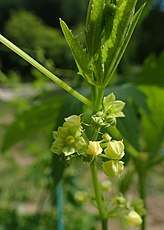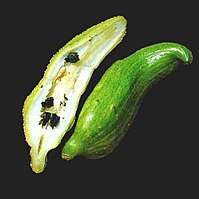Cyclanthera pedata
Cyclanthera pedata, known as caigua, is a herbaceous vine grown for its edible fruit, which is predominantly used as a vegetable. It is known from cultivation only, and its use goes back many centuries as evidenced by ancient phytomorphic ceramics from Peru depicting the fruits.
| Caigua | |
|---|---|
| Scientific classification | |
| Kingdom: | Plantae |
| Clade: | Tracheophytes |
| Clade: | Angiosperms |
| Clade: | Eudicots |
| Clade: | Rosids |
| Order: | Cucurbitales |
| Family: | Cucurbitaceae |
| Genus: | Cyclanthera |
| Species: | C. pedata |
| Binomial name | |
| Cyclanthera pedata (L.) Schrader | |
| Synonyms[1] | |
| |
Origin and distribution
Not known in the wild, but presumably native to the Andes where it has been traditionally cultivated.[2]
Description
Cyclanthera pedata is a vine that can be 12 m long; the stems are thin; and the leaves can be up to 24 cm long, palmate or pedate in shape.[2] The small flowers can be greenish or white and are borne in racemes.[2] The fruit is light green, ovoid, curved, up to 15 cm long, almost hollow (except for the seeds and a thin flesh layer), with smooth skin or sometimes covered in soft spines; the seeds are black.[2][3]

Cultivation
Cyclanthera pedata is grown at small scale farming in mountain areas of Mexico, Central America and South America.[2] It is sometimes cultivated in Asia.[2] This species can be grown in mountain areas up to 2000, being adapted to cool temperatures.[2][4]
Vernacular names
Known in the Andes as caigua[4] or caihua[4] (possibly from Quechua kaywa);[5] also as achocha[4] (possibly from Quechua achuqcha).[5] In English it is named stuffing cucumber or slipper gourd.[2]
Uses
Food
The fruits are eaten after removing the seeds and stuffing them with other foods like rice or meat, and then cooking them.[2] Young shoots and leaves can also be eaten as greens.[2] The fruits are a source of potassium, magnesium and phosphorus.[6] Fruit flavor might be similar to cucumber or otherwise tasteless.[2][3]
| Nutritional value per 100 g (3.5 oz) | |
|---|---|
| Energy | 17 kcal (71 kJ) |
4 g | |
| Dietary fiber | 0.7 g |
0.1 g | |
0.6 g | |
| Vitamins | Quantity %DV† |
| Thiamine (B1) | 3% 0.04 mg |
| Riboflavin (B2) | 3% 0.04 mg |
| Niacin (B3) | 2% 0.3 mg |
| Vitamin C | 17% 14 mg |
| Minerals | Quantity %DV† |
| Calcium | 1% 14 mg |
| Iron | 2% 0.21 mg |
| Magnesium | 2% 8.4 mg |
| Phosphorus | 4% 26 mg |
| Potassium | 3% 152 mg |
| Sodium | 0% 0.91 mg |
| Other constituents | Quantity |
| Water | 94.1 % |
| |
| †Percentages are roughly approximated using US recommendations for adults. | |
Chemistry
The fruits contain flavonoid glycosides[8] of which four show an antioxidant effect.[9]
Caigua fruits generally exhibit high antioxidant activity but a low total phenolic content, which indicates that non-phenolic water-soluble compounds might be involved.[10] Flavonoids are present in this cyclanthera species, which have antioxidant properties as well and were shown that with a high intake are correlated to a decrease in heart disease.[8]

Dried samples of caigua showed α-amylase inhibition and relevant ACE inhibitory activities.[10]
A negative aspect of caigua is, that the seeds contain a group of trypsin inhibitors, which negatively affect protein absorption.[11]
Other chemicals in the Caigua include triterpenoid saponins and the seeds have been reported with six cucurbitacin glycosides.[12] as well as 28-30 amino acids.[11]
Archaeology

The Moche culture often depicted this species in their ceramics.[13] Remains of this species have also been found buried in archaeological sites on the Peruvian coast.[14]
References
- The Plant List: A Working List of All Plant Species, retrieved 8 May 2016
- Janick, Jules; Paull, Robert E. (2008). The Encyclopedia of Fruit and Nuts. CABI. p. 299. ISBN 9780851996387.
- Brücher, Heinz (2012). Useful Plants of Neotropical Origin: and Their Wild Relatives. Springer Science & Business Media. p. 265. ISBN 9783642733130.
- Innovation, National Research Council (U S. ) Advisory Committee on Technology (1989). Lost Crops of the Incas: Little-known Plants of the Andes with Promise for Worldwide Cultivation. National Academies. pp. 206–207.
- Diccionario Quechua - Español - Quechua, Academía Mayor de la Lengua Quechua, Gobierno Regional Cusco, Cusco 2005 (Quechua-Spanish dictionary) see: achoqcha
- Oliveira, A. C., dos Santos, V. S., dos Santos, D. C., Carvalho, R. D. S., Souza, A. S., & Ferreira, S. L. C. (2014). Determination of the mineral composition of Caigua (Cyclanthera pedata) and evaluation using multivariate analysis. Food Chemistry, 152, 619–623.
- Rubatzky, V. E., & Yamaguchi, M. (1997). World Vegetables: Principles, Production, and Nutritive Values (2nd ed.). Springer. p. 811
- Carbone, V., Montoro, P., De Tommasi, N., & Pizza, C. (2004). Analysis of flavonoids from Cyclanthera pedata fruits by liquid chromatography/electrospray mass spectrometry. Journal of Pharmaceutical and Biomedical Analysis, 34(2), 295–304.
- Montoro, P., et al. “Studies on the constituents of Cyclanthera pedata fruits: isolation and structure elucidation of new flavonoid glycosides and their antioxidant activity.” J. Agric. Food Chem. 2001; 49(11): 5156-60.
- Ranilla, L. G., Kwon, Y. I., Apostolidis, E., & Shetty, K. (2010). Phenolic compounds, antioxidant activity and in vitro inhibitory potential against key enzymes relevant for hyperglycemia and hypertension of commonly used medicinal plants, herbs and spices in Latin America. Bioresource Technology, 101(12), 4676–4689.
- Kowalska, J., et al. “Isolation and primary structures of seven serine proteinase inhibitors from Cyclanthera pedata seeds.” Biochim. Biophys. Acta. 2006; 1760(7): 1054-63.
- De Tommasi, N., et al. Studies on the constituents of Cyclanthera pedata (caigua) seeds: isolation and characterization of six new Cucurbitacin glycosides.” J. Agr. Food Chem. 1996; 44(8): 2020-2025.
- Berrin, K. & Larco Museum (1997). The Spirit of Ancient Peru: Treasures from the Museo Arqueológico Rafael Larco Herrera. Thames and Hudson, New York.
- Nelson, Kit; Bellido Cerda, Enrique (2010). "Evidence of Botanical Diversity and Species Continuity from Chancay Sites in The Huaura Valley, Peru1". Economic Botany. 64 (1): 46–54. doi:10.1007/s12231-010-9112-5. ISSN 0013-0001.
| Wikimedia Commons has media related to Cyclanthera pedata. |